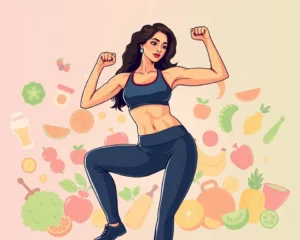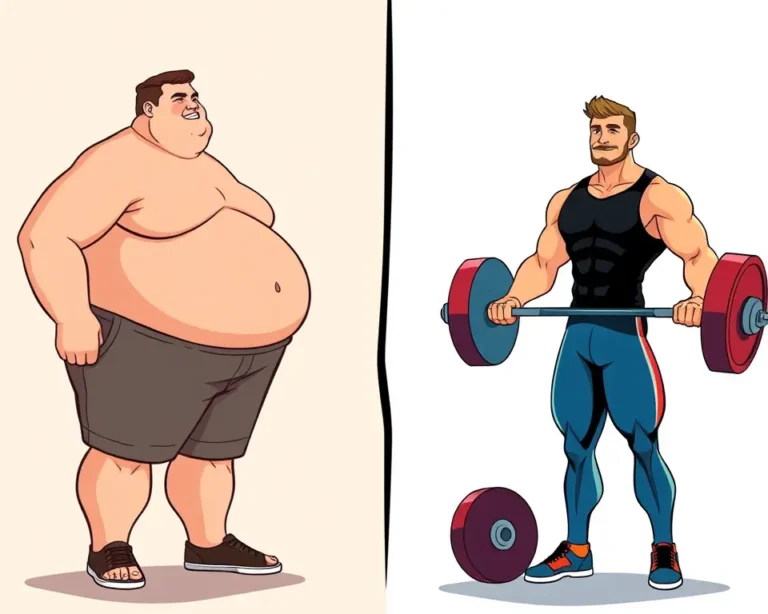For years, I struggled with my weight, bouncing between fad diets and fleeting cardio routines. Nothing seemed to stick. Then, I discovered powerlifting, and everything changed. In just over a year, I lost 90lbs (41kg), not by starving myself or spending hours on the treadmill, but by lifting heavy weights and learning to love my strength.
The Turning Point: Ditching Cardio for Compound Lifts
Like many, I used to believe that cardio was the key to weight loss. I’d spend hours running, cycling, and doing aerobics, only to see minimal results and feel constantly exhausted. It wasn’t until I stumbled upon powerlifting that I realized there was a different path.
Powerlifting focuses on three main lifts:
- Squat: The king of all exercises, working your legs, core, and back.
- Bench Press: Primarily targets your chest, shoulders, and triceps.
- Deadlift: A full-body exercise that builds incredible strength in your back, legs, and grip.
These compound movements engage multiple muscle groups simultaneously, leading to a higher calorie burn compared to isolation exercises or steady-state cardio. Revive Fitness confirms that these movements lead to a higher calorie burn, especially squats and deadlifts which intensely engage core muscles.
Why Powerlifting Works for Weight Loss
There are several reasons why powerlifting can be an effective weight loss tool:
- Increased Muscle Mass: Muscle burns more calories than fat, even at rest. Powerlifting builds muscle, boosting your metabolism 24/7.
- Afterburn Effect: Heavy lifting creates an “afterburn effect,” where your body continues to burn calories for hours after your workout.
- Hormonal Benefits: Lifting heavy weights stimulates the production of growth hormone and testosterone, both of which play important roles in fat burning and muscle building.
One study showed a 15% increase in caloric demand over a 24-hour period due to powerlifting.
The Powerlifting Program: Heavy Weights, Fewer Reps
My powerlifting program revolved around the three main lifts, performed 3-4 times per week. I focused on lifting heavy weights for fewer reps (3-5 reps per set), with the goal of increasing my strength over time. This approach, known as progressive overload, is crucial for continued progress.
Here’s a sample weekly routine:
- Day 1: Squats, Bench Press, Accessory exercises (rows, overhead press)
- Day 2: Deadlifts, Overhead Press, Accessory exercises (pull-ups, dips)
- Day 3: Rest
- Day 4: Squats, Bench Press, Accessory exercises (rows, lateral raises)
Accessory Work: Supporting the Main Lifts
While the main lifts are the foundation of a powerlifting program, accessory exercises play a vital role in supporting them. These exercises target specific muscle groups, improve stability, and prevent injuries.
Examples of accessory exercises include:
- Rows
- Overhead Press
- Pull-ups
- Dips
- Lunges
- Planks
Nutrition: Fueling Strength and Fat Loss
While powerlifting was essential for building muscle and burning calories, nutrition was equally important for weight loss. “You can’t out-train a bad diet,” as they say. Combining powerlifting with proper nutrition is key to successful weight loss.
I focused on eating a balanced diet consisting of:
- Protein: Essential for muscle repair and growth. Aim for 1.2 to 2.2 grams of protein per kilogram of body weight. Good sources include lean meats, poultry, fish, eggs, and dairy.
- Carbohydrates: Your primary energy source. Opt for complex carbohydrates like oats, brown rice, and sweet potatoes. Powerlifters typically consume 4 to 7 grams of carbohydrates per kilogram of body weight.
- Fats: Important for hormone production and overall health. Choose healthy fats like avocados, olive oil, and nuts.
Calorie Deficit: The Key to Fat Loss
To lose weight, I needed to be in a calorie deficit, meaning I was burning more calories than I was consuming. I achieved this by tracking my calorie intake and making sure I was eating fewer calories than my body was burning.
I found it easiest to count calories and practice portion control.
Sample Daily Meal Plan
Here’s what I typically eat in a day now:
- Breakfast: Oatmeal with protein powder and berries
- Lunch: Chicken breast with brown rice and vegetables
- Dinner: Salmon with sweet potato and green beans
- Snacks: Greek yogurt, nuts, fruit
The Mental Game: Building Confidence and Discipline
Powerlifting is not just a physical challenge; it’s also a mental one. It requires discipline, patience, and a strong mindset. As I progressed in my training, I not only saw changes in my body but also experienced significant improvements in my mental health.
Increased Self-Esteem and Confidence
Achieving new personal bests in the gym gave me a sense of accomplishment and boosted my self-esteem. I started to feel more confident in my own skin, regardless of the number on the scale.
Stress Reduction and Mood Enhancement
Lifting weights became a therapeutic outlet for stress and anxiety. The rhythmic clinking of weights triggered the release of endorphins, nature’s stress busters.
Body Image Improvement
Powerlifting helped me shift my focus from how my body looked to what it could do. I started to appreciate my strength and resilience, rather than fixating on perceived flaws. Witnessing the tangible results of your efforts fosters a positive body image, elevating self-esteem and confidence
Overcoming Challenges: Plateaus and Injuries
Like any fitness journey, my powerlifting weight loss transformation wasn’t without its challenges. I experienced plateaus in my strength and occasional injuries. However, I learned to overcome these obstacles by:
- Adjusting my training: Varying my exercises, rep ranges, and sets to challenge my body in new ways.
- Prioritizing recovery: Getting enough sleep, eating a balanced diet, and incorporating active recovery days.
- Seeking professional help: Consulting with a physical therapist or coach to address injuries and improve my technique.
The Results: More Than Just Weight Loss
After just over a year of powerlifting and consistent nutrition, I lost 90lbs (41kg) and transformed my body and mind. But the results went far beyond just weight loss.
- Increased Strength: I can now squat, bench press, and deadlift weights I never thought possible.
- Improved Body Composition: I gained muscle and lost fat, resulting in a leaner, more toned physique.
- Enhanced Mental Health: I feel more confident, resilient, and happier than ever before.
Powerlifting: A Sustainable Lifestyle
Powerlifting is not a quick fix; it’s a sustainable lifestyle that promotes long-term health and well-being. It’s about building strength, both physically and mentally, and learning to love your body for what it can do. Moving and staying active is what kept my motivation high.
If you’re looking for a way to lose weight, build strength, and improve your overall health, I highly recommend giving powerlifting a try. It might just change your life, as it did mine.







